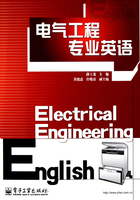
Lesson Five A.C.Motor’s Protection
The great advantage of A.C. motors of the cage type is the facility of direct-on-line (d.o.l) starting, i.e. without the use of external resistances. Nevertheless this introduces fresh problem for overload and short-circuit protection because of the initial rush of starting current, usually of the order of 5 to 7times full load current (f.l.c.). The protective device must be inoperative during the starting period but operative on normal overload and on short circuit and under stalled conditions.
Motors are now rated on a continuous maximum rating (CMR) basis, i.e. they are not required to have any margin or capacity for continuous or prolonged overload operation. This needs overload protection at a low level, say 15% to 25% overloads, for short periods. Overload protection should be set preferably at the working load current and not according to the motor current shown on the motor rating plate. Two speed change-pole motors require two overload relays to suit the f.l.c. of each speed.
Overload protective devices can be one or more of the following:
(1) Thermal relays;
(2) Magnetic relays;
(3) Protective devices built into the motor.
Thermal overload relays can be either bi-metal relays or fusible metal relays.
The elements of the bi-metal relay are sensitive to changes in ambient air temperature and some manufacturers incorporate temperature compensation in the design.
As it is the final temperature and not the temperature rise which is the determining factor in the life of winding insulation, the relay should take into account the ambient temperature rises. By this means the motor will be disconnected at an approximately constant final temperature.
Magnetic overload relays are of the solenoid type consisting of an iron plunger surrounded by a coil, one for each phase protected. The coil carries line current or a proportion of it is current transformers are used. At the predetermined value the plunger is attracted to the centre of the coil and a push rod actuates a trip bar which opens an auxiliary contact in an operating coil circuit or actuates a mechanical latch. Adjustment of trip current setting is by raising or lowering the plunger.
To prevent instantaneous tripping on momentary overloads, or on starting current, a time lag device is attached to each plunger. This can be either a mechanical escapement or an oil dashpot, but the latter is the most usually used.
Magnetic and thermal protective relays depend on sensing currents or current changes and can’t deal with overheating conditions in motor which are not due to current alone. Circumstances which result in overheating without influencing current are numerous. To mention but a few would include lack of normal cooling such as blocked air vents and excessive local ambient temperatures.
Temperature sensing systems built into the motor windings, particularly heritor probes provide for these conditions but for best all-round protection overload relays should also be incorporated. Thermal protection is not effective against all fault and abnormal conditions.
The most commonest cause of single-phasing is the blowing of one of the three fuses protecting the current. Low-voltage releases do not provide protection against single-phasing, because a low-voltage release may still be fed from the healthy phase. Overheating will occur in star connected machines continuing to run single-phasing but in these cases the line current is the same as that in the windings and there is a better chance that the overland relay will operate. For stat-delta starting one type of protection takes the form of at least two bi-metal thermal strips, one in each phase, all at least two strips can respond together to a balanced three phase overload but one or two of the strips will act independently in the event of single-phasing. An alternative method is to connect overload relays in the delta connection in series with each winding. In systems with earthed neutral, single-phasing will occur if a fuse blows due to an earth fault on one line.
New Words and Expressions
facility [fəˈsiliti] n. 工具
direct-on-line starting 直接启动
rush[rʌ∫] n. 冲击,激增
inoperative[inˈɔpərətiv] adj. 不起作用的
stall[stɔːl] vt. 停车,堵转,出故障
continuous maximum rating(CMR) 持续最大功率
margin[ˈmɑːdʒin] n. 余地,余裕,安全系数
change-pole motor 变极式电动机
thermal[ˈθəːməl] adj. 热的
bi-metal n. 双金属
fusible[ˈfjuːzəbl] adj. 易熔的,可熔化的
element[ˈelimənt] n. 元件,原理
ambient [ˈæmbiənt] adj. 周围的
compensation [kɔmpenˈsei∫ən] n. 补偿
solenoid[ˈsəulinɔid] n. 螺线管(线圈)
plunger[ˈplʌndʒə] n. 插棒式铁芯
attract[əˈtrækt] vt. 吸引
rod[rɔd] n. 杆,棒
actuate[ˈæktjueit] vt. 使动作,驱动,操纵
latch[læt∫] n. 插锁,凸轮
setting[ˈsetiŋ] n. 整定值,安装
escapement[isˈkeipmənt] n. 棘轮装置,操纵机构
thermistor[θəːˈmistə] n. 热敏电阻
probe[prəub] n. 探头,探测器,传感器
abnormal[æbˈnɔːməl] adj. 不正常的
blow[bləu] vi. 烧断(熔断器)
star[stɑː] adj. 星形的
star-delta n. 星形三角形
strip[strip] n. 条,片,带
neutral [ˈnjuːtrəl ] adj. 中性的;n. 中性线
Notes
(1)…the facility of direct-on-line…
句中“direct-on-line”是一个合成词,意思是“直接投入电网”。英语构词的方法主要有三种,即合成法、转化法和派生法。由两个或两个以上的单词构成一个新词的方法叫合成法。“direct-on-line”就是以这种方法构成的合成词,合成词的各组成部分有时用连词符号,有时不用,按习惯而定。
如:high-quality高质量;the most widely used应用最广泛的
(2)usually of the order of 5 to 7times…
句中“of the order of”意为“大约,约为”。也可翻译为“数量级为……的或……左右的”。
例如:
Changes in resistance under normal working conditions may be of the order of 5 percent.
正常工作条件下,电阻值的变化率可以在5% 左右。
Maximum signal currents are of the order of 50 mA.
最大信号电流是在50毫安这个数量级范围。
(3)…15% to 25% 读做“fifteen percent to twenty-five percent”,百分数的读法应该先读基数词,再读百分比符号。
(4)…should take into account…
句中“take into account”意为“考虑”。加重语气时可以在take后加fully意为“充分考虑”。
例如:
The people’s desired must be taken fully into account.
必须充分考虑人们的愿望。
The law takes fully into account forms of energy other than those discussed so far.(other than意为“除……以外”)
除了到目前为止所讨论的那些能量形式以外,该定律还充分考虑了其他能量形式。
(5)…relays are of the solenoid type…
“be+of+抽象名词”的结构表示种属或性质,of与它后面的名词相当于一个形容词,可作表语。
例如:
1) This problem is of importance.(of importance=important) 这个问题很重要。
2) This machine is of use. (of use=useful) 这台机器是有用的。
3) The rubber ring we want is of metric system, not of English system.
我们要的橡圈是公制的,而不是英制的。